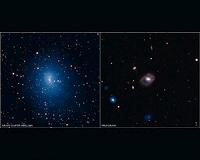 |
Tel Aviv, Israel (SPX) Dec 28, 2010 Most galaxies in the universe, including our own Milky Way, harbor super-massive black holes varying in mass from about one million to about 10 billion times the size of our sun. To find them, astronomers look for the enormous amount of radiation emitted by gas which falls into such objects during the times that the black holes are "active," i.e., accreting matter. This gas "infall" into massive black holes is believed to be the means by which black holes grow. Now a team of astronomers from Tel Aviv University, including Prof. Hagai Hetzer and his research student Benny Trakhtenbrot, have determined that the era of first fast growth of the most massive black holes occurred when the universe was only about 1.2 billion years old - not two to four billion years old, as was previously believed - and they're growing at a very fast rate. The results will be reported in a new paper soon to appear in Astrophysical Journal.
The oldest are growing the fastest The data obtained with the advanced instrumentation on these telescopes show that the black holes that were active when the universe was 1.2 billion years old are about ten times smaller than the most massive black holes that are seen at later times. However, they are growing much faster. The measured rate of growth allowed the researchers to estimate what happened to these objects at much earlier as well as much later times. The team found that the very first black holes, those that started the entire growth process when the universe was only several hundred million years old, had masses of only 100-1000 times the mass of the sun. Such black holes may be related to the very first stars in the universe. They also found that the subsequent growth period of the observed sources, after the first 1.2 billion years, lasted only 100-200 million years. The team found that the very first black holes - those that started growing when the universe was only several hundred million years old - had masses of only 100-1000 times the mass of the sun. Such black holes may be related to the very first stars in the universe. They also found that the subsequent growth period of these black holes, after the first 1.2 billion years, lasted only 100-200 million years. The new study is the culmination of a seven year-long project at Tel Aviv University designed to follow the evolution of the most massive black holes and compare them with the evolution of the galaxies in which such objects reside. Other researchers on the project include Prof. Ohad Shemmer of the University of North Texas, who took part in the earlier stage of the project as a Ph.D student at Tel Aviv University, and Prof. Paulina Lira, from the University of Chile.
Share This Article With Planet Earth
Related Links Tel Aviv University Understanding Time and Space
 How Often Do Giant Black Holes Become Hyperactive
How Often Do Giant Black Holes Become HyperactiveBoston MA (SPX) Dec 21, 2010 A new study from NASA's Chandra X-ray Observatory tells scientists how often the biggest black holes have been active over the last few billion years. The object could help scientists better understand how massive stars explode, which ones leave behind black holes or neutron stars, and how many black holes are in our galaxy and others. This discovery clarifies how supermassive black holes ... read more |
|
| The content herein, unless otherwise known to be public domain, are Copyright 1995-2010 - SpaceDaily. AFP and UPI Wire Stories are copyright Agence France-Presse and United Press International. ESA Portal Reports are copyright European Space Agency. All NASA sourced material is public domain. Additional copyrights may apply in whole or part to other bona fide parties. Advertising does not imply endorsement,agreement or approval of any opinions, statements or information provided by SpaceDaily on any Web page published or hosted by SpaceDaily. Privacy Statement |